This data snapshot summarizes federal data on instructional faculty appointments and graduate student employment in US medical schools.1 The primary data source is the Integrated Postsecondary Education Data System (IPEDS) Employees by Assigned Position (EAP) survey component, an annual survey that became mandatory in 2002–03 for all institutions participating in Title IV federal financial-aid programs.2
Academic Appointments in Medical Schools
Long-standing AAUP policies recognize only three types of full-time faculty appointments: (a) tenured (with continuous tenure), (b) tenure-track (probationary for tenure), and (c) non-tenure-track (special appointments), which should be clearly designated at the outset as involving only a brief association with the institution.3 That is because the Association views tenure as a right accruing to all faculty members successfully completing the probationary period, not as a privilege or reward granted to a select few. However, the Association also recognizes that faculty appointments in medical schools are often different from those in other parts of the academy, encompassing diverse educational and research interests as well as entrepreneurial activities in the form of clinical practice and patient care. Given the multiple purposes of academic medical schools, the variety of their academic appointments, and the volatility of the environment in which they function, some have questioned whether tenure is necessary in medical schools. The Association addressed this question in its 1999 report Tenure in the Medical School, which states, “To the extent that a faculty appointment at a medical school resembles a traditional academic appointment with clearly understood obligations in teaching, research, and service, the burden of proof on the institution is greater to justify making the appointment to a non-tenure-track position.”
The term contingent refers to appointments that are ineligible for tenure, highlighting the tenuous relationship between academic institutions and the faculty members holding such appointments. This data snapshot disaggregates full-time contingent appointments into two categories—non-tenure-track and no tenure system—to distinguish faculty hired off the tenure track from those working in institutions that do not have a tenure system at all. Part-time faculty appointments are reported in one category. Figures in this data snapshot represent appointments held by instructional staff, with or without formal faculty status, in degree-granting nonprofit medical schools.
Summary of Findings
The proportion of instructional faculty members holding full-time tenured or tenure-track appointments has declined steadily in US medical schools (see figure 1).
- About 26 percent of faculty members held full-time tenured or tenure-track appointments in fall 2023, compared with about 39 percent in fall 2002.
- About 14 percent of faculty members held full-time tenured appointments in fall 2023, compared with about 23 percent in fall 2002.
- About 12 percent of faculty members were on tenure-track appointments in fall 2023, compared with about 17 percent in fall 2002.
- About 21 percent of faculty members were employed part time in fall 2023, compared with about 20 percent in fall 2002.
The percentage of instructional faculty members holding tenured or tenure-track appointments in US medical schools declined among all institution types from fall 2002 to fall 2023 (see figure 2).
- The overall percentage of faculty members holding tenured or tenure-track appointments decreased from about 42 percent to about 28 percent.
- Conversely, the overall percentage of faculty members holding contingent appointments that are ineligible for tenure increased from about 58 percent to about 72 percent.
- In fall 2023, the percentage of faculty members holding tenured or tenure-track appointments ranged from about 25 percent among public institutions to about 33 percent among religiously affiliated institutions.
- The percentage of faculty members holding tenured or tenure-track appointments decreased about 17 percentage points among public institutions, the most among all institution types.
The number of instructional faculty members holding contingent appointments in medical schools increased substantially from fall 2002 to fall 2023, while the number holding tenured or tenure-track appointments barely changed (see figure 3).
- Full-time contingent appointments increased about 133 percent.
- Full-time tenured appointments increased about 7 percent.
- Full-time tenure-track appointments increased about 26 percent.
- Part-time contingent appointments increased about 87 percent.
Most instructional faculty members holding contingent appointments in medical schools were on renewable contracts in fall 2023 (see figure 4).
- About 82 percent of faculty members on full-time contingent appointments were on renewable (annual or multiyear) contracts.
- About 69 percent of faculty members on part-time contingent appointments were on renewable short-term contracts.
The number of graduate student employees with teaching or research responsibilities in medical schools has increased in recent years (see figure 5).
- The number of graduate student employees with teaching or research responsibilities increased by about 28 percent from fall 2002 to fall 2023.
Conclusion
Tenure is available to faculty members at over 80 percent of US medical schools4 and continues to shape faculty staffing policies at all medical schools to a great extent. However, tenure procedures at medical schools have often deviated from those in other parts of the academy, especially with respect to the length of probationary periods, provisions for stopping the tenure clock, the financial guarantee of tenure, and post-tenure review.5 Nonetheless, key features of tenure remain at the core of faculty employment policies at medical schools.6
US medical schools have increasingly relied on faculty members holding contingent appointments that are ineligible for tenure, as this data snapshot has documented. Its findings align with those of William T. Mallon and Natalya Cox,7 whose fall 2022 survey on faculty appointment, promotion, and tenure policies at 155 US medical schools found that the percentage of full-time clinical faculty members holding tenured or tenure-track appointments declined from about 59 percent in 1982 to about 18 percent in 2022. The findings are also consistent with earlier findings of Sarah A. Bunton and April M. Corrice,8 who analyzed data collected by the Association of American Medical Colleges in its 2008 Faculty Personnel Policies Survey and found that the percentage of clinical faculty in medical schools declined from about 59.6 percent in 1984 to about 32.9 percent in 2008.
About 72 percent of faculty members in US medical schools hold contingent appointments that are ineligible for tenure, and in the current economic and political climate, clinical faculty members would be well advised to become familiar with the AAUP’s 1999 statement Academic Freedom in the Medical School, its 1995 report Tenure in the Medical School, and other resources on tenure. Given the entrepreneurial context of many medical schools, clinical faculty conducting research may also wish to refer to the Association’s 1990 Statement on Conflicts of Interest, its 2004 Statement on Corporate Funding of Academic Research, and the book-length 2014 Recommended Principles to Guide Academy-Industry Relationships.
Glenn Colby is senior researcher at the AAUP.
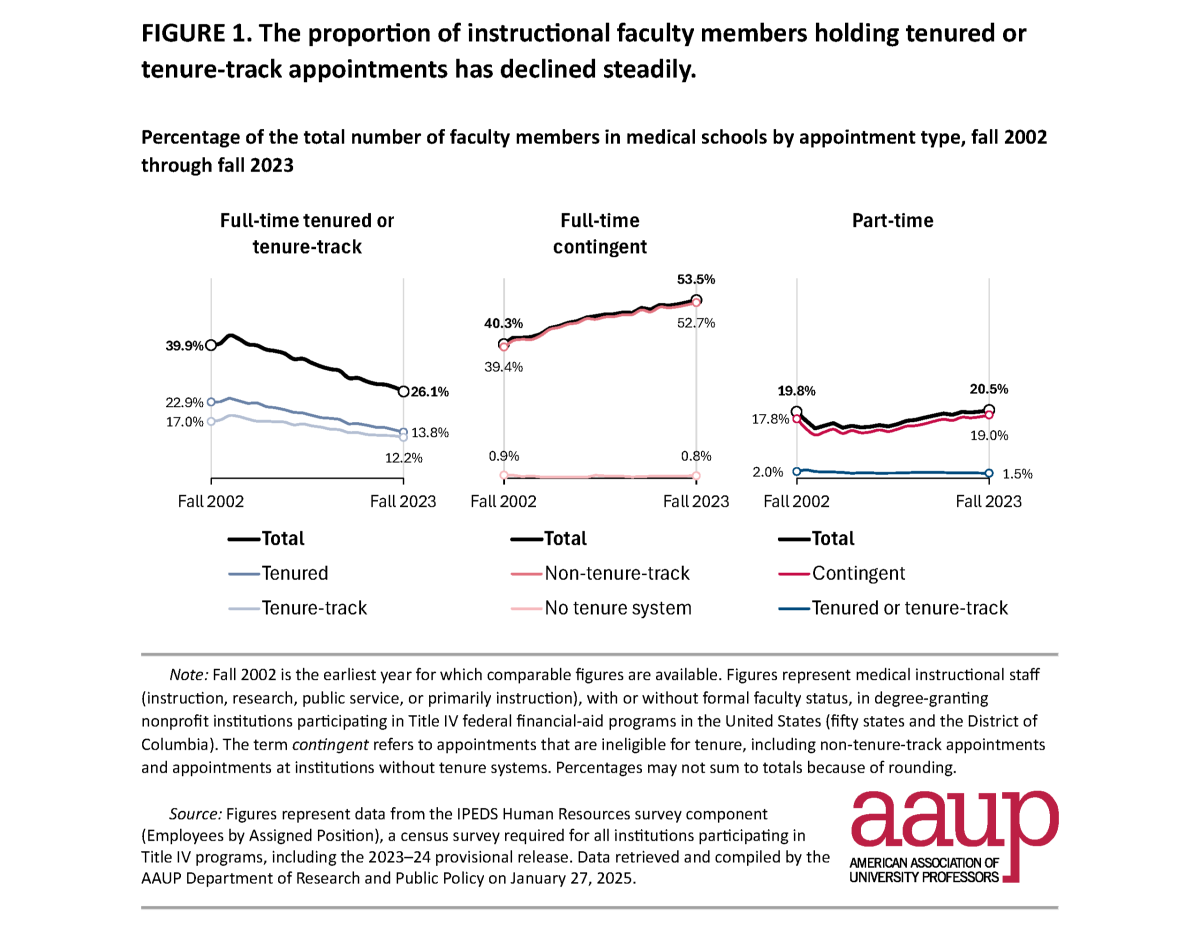
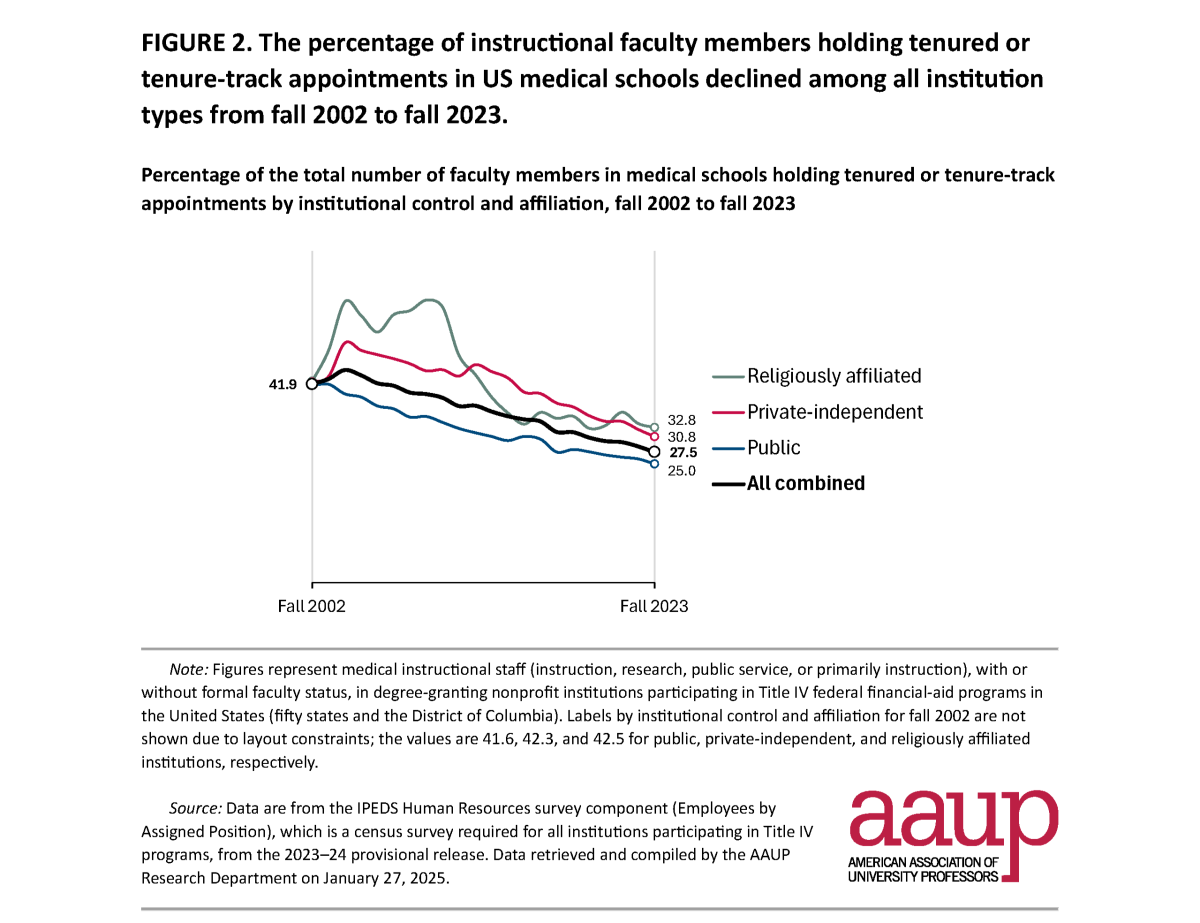
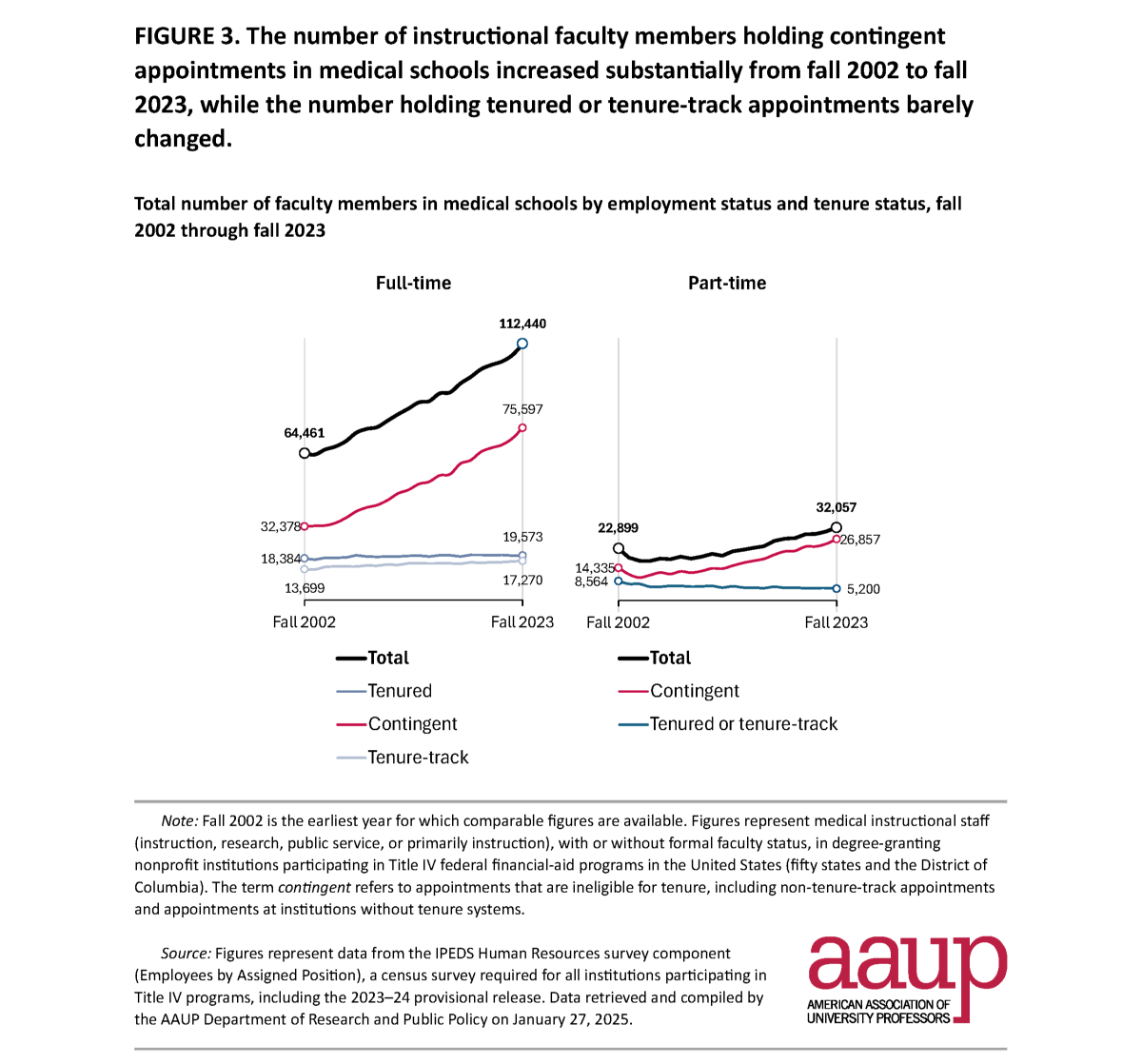
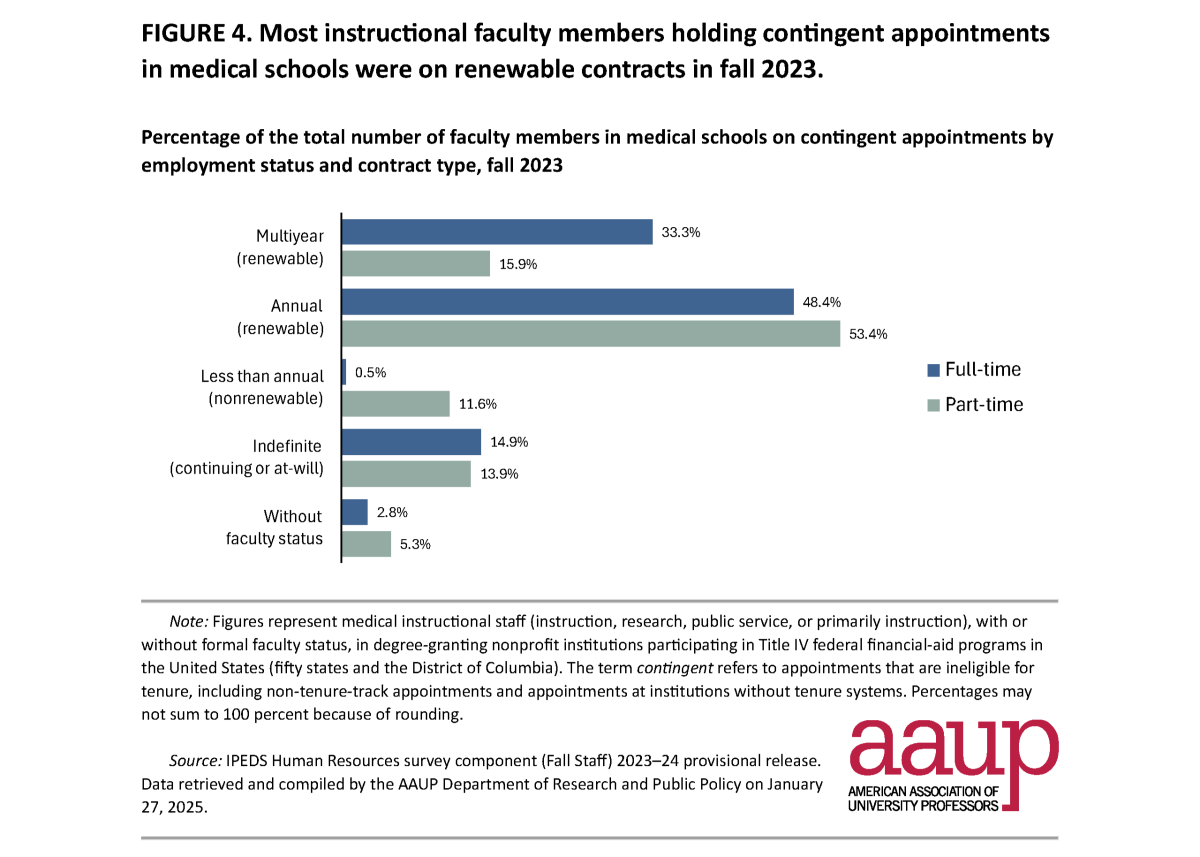
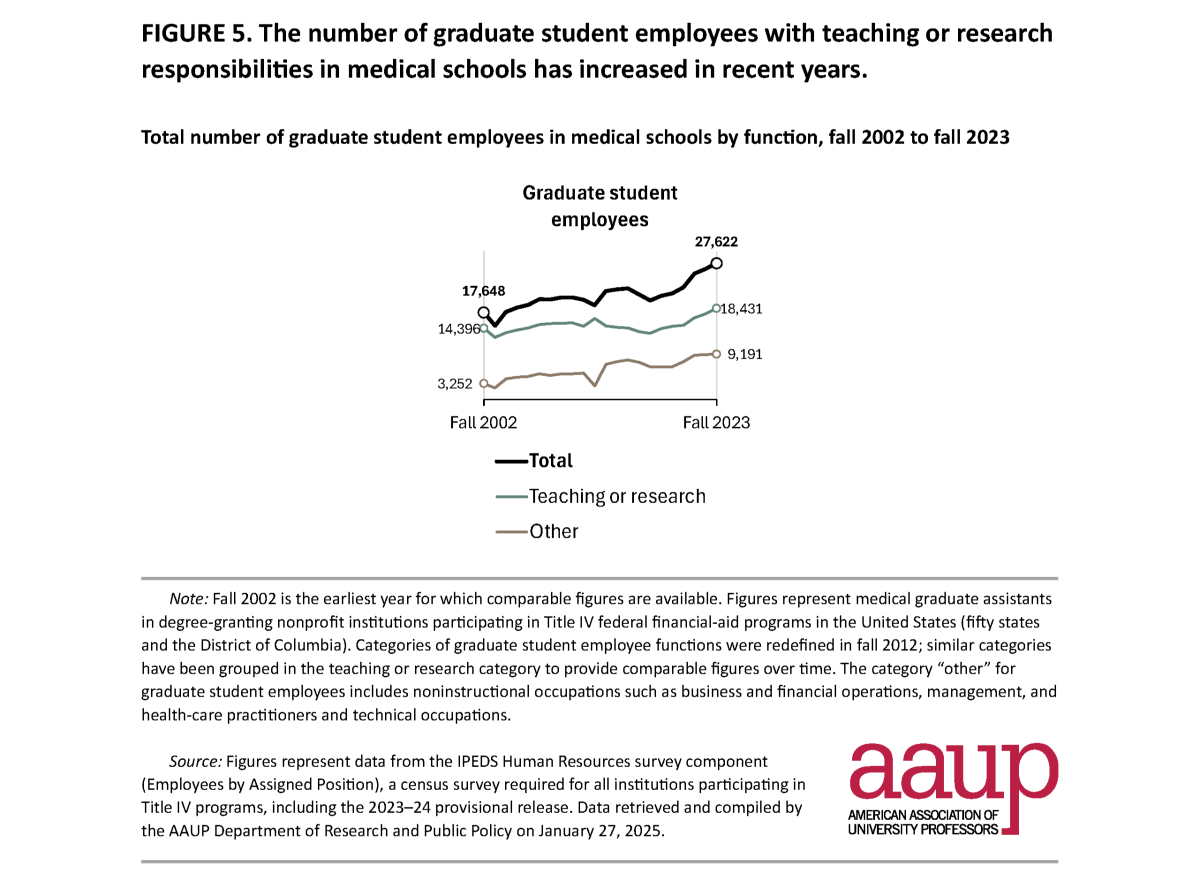
Notes
1. Federal data on nonmedical instructional faculty appointments and graduate student employment is summarized in a companion publication: Glenn Colby, “Data Snapshot: Tenure and Contingency in US Higher Education, Fall 2023,” Academe 111 (Spring 2025), https://www.aaup.org/article/data-snapshot-tenure-and-contingency-us-higher-education-fall-2023.
2. Employees who are in health disciplines that are not part of a medical school are not reported as medical employees. Beginning in 2004–05, IPEDS limited the collection of data on medical schools to those with doctor of medicine or doctor of osteopathic medicine programs.
3. See the AAUP’s 2010 report Tenure and Teaching-Intensive Appointments.
4. Among the 178 medical schools reporting data to IPEDS for fall 2023, 143 reported having ten or more instructional faculty members on tenured or tenure-track appointments.
5. William T. Mallon and Natalya Cox, “Promotion and Tenure Policies and Practices at U.S. Medical Schools: Is Tenure Irrelevant or More Relevant than Ever?,” Academic Medicine 99, no 7 (2024): 724–32, https://doi.org/10.1097/ACM.0000000000005689.
6. Even Boston University—the largest medical school in the United States without a tenure system—has implemented faculty employment policies aligned with AAUP-recommended policies concerning tenure, such as its “Suspension or Termination for Cause” policy, which was largely derived from the procedural recommendations listed in the AAUP’s Statement on Procedural Standards in Faculty Dismissal Proceedings.
7. William T. Mallon and Natalya Cox, “Promotion and Tenure Policies and Practices at U.S. Medical Schools: Is Tenure Irrelevant or More Relevant than Ever?,” Academic Medicine 99, no 7 (2024): 724–32, https://doi.org/10.1097/ACM.0000000000005689.
8. Sarah A. Bunton and April M. Corrice, “Trends in Tenure for Clinical M.D. Faculty in U.S. Medical Schools: A 25-Year Review,” Analysis in Brief 9, no. 9 (2010): 1–2, https://www.aamc.org/data-reports/analysis-brief/report/trends-tenure-clinical-md-faculty-us-medical-schools-25-year-review.



